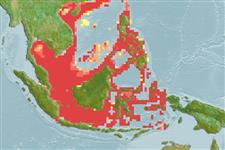>
Eupercaria/misc (Various families in series Eupercaria) >
Nemipteridae (Threadfin breams, Whiptail breams)
Etymology: Nemipterus: Greek, nema, -atos = filament + Greek, pteron = wing, fin (Ref. 45335).
More on author: Bleeker.
Environment: milieu / climate zone / depth range / distribution range
Ökologie
seewasser demersal; standorttreu. Tropical; 22°N - 9°S, 96°E - 131°E (Ref. 3810)
Western Central Pacific: including the Philippines, Gulf of Thailand, South China Sea, Strait of Malacca and Indonesia.
Size / Gewicht / Alter
Maturity: Lm ? range ? - ? cm
Max length : 21.0 cm SL Männchen/unbestimmt; (Ref. 3810); common length : 17.0 cm SL Männchen/unbestimmt; (Ref. 3810)
Rückenflossenstacheln (insgesamt) : 10; Rückenflossenweichstrahlen (insgesamt) : 9; Afterflossenstacheln: 3; Afterflossenweichstrahlen: 7. Suborbital spine absent. Preopercle with three transverse scale rows. Pectoral and pelvic fins moderately long, reaching to or just short of level of anus. A line drawn up from posterior edge of suborbital reaching the dorsal profile at about 3 to 7 scale rows before origin of dorsal fin. Upper lobe of caudal fin produced into a trailing yellow filament. Axillary scale present. Color: Upper body pinkish, pearly white below. Membrane of first 2 dorsal spines bright red superiorly. Golden yellow stripe from posterior nostril through eye and from upper lip to lower eye.
Inhabits muddy or sandy bottoms. Feeds on small fishes and larger benthic invertebrates. Most abundant species of Nemipterus in bottom trawl catches from the South China Sea.
Life cycle and mating behavior
Maturities | Fortpflanzung | Spawnings | Egg(s) | Fecundities | Larven
Russell, B.C., 1990. FAO Species Catalogue. Vol. 12. Nemipterid fishes of the world. (Threadfin breams, whiptail breams, monocle breams, dwarf monocle breams, and coral breams). Family Nemipteridae. An annotated and illustrated catalogue of nemipterid species known to date. FAO Fish. Synop. 125(12):149p. Rome: FAO. (Ref. 3810)
IUCN Rote Liste Status (Ref. 130435)
Bedrohung für Menschen
Harmless
Nutzung durch Menschen
Fischereien: weniger kommerziell
Tools
Zusatzinformationen
Download XML
Internet Quellen
Estimates based on models
Preferred temperature (Ref.
123201): 22.5 - 28.6, mean 27.6 °C (based on 489 cells).
Phylogenetic diversity index (Ref.
82804): PD
50 = 0.5000 [Uniqueness, from 0.5 = low to 2.0 = high].
Bayesian length-weight: a=0.01380 (0.00880 - 0.02165), b=2.96 (2.83 - 3.09), in cm total length, based on LWR estimates for this species & Genus-body shape (Ref.
93245).
Trophic level (Ref.
69278): 4.0 ±0.66 se; based on food items.
Widerstandsfähigkeit (Ref.
120179): mittel, Verdopplung der Population dauert 1,4 - 4,4 Jahre. (K=0.28).
Fishing Vulnerability (Ref.
59153): Low to moderate vulnerability (26 of 100).
